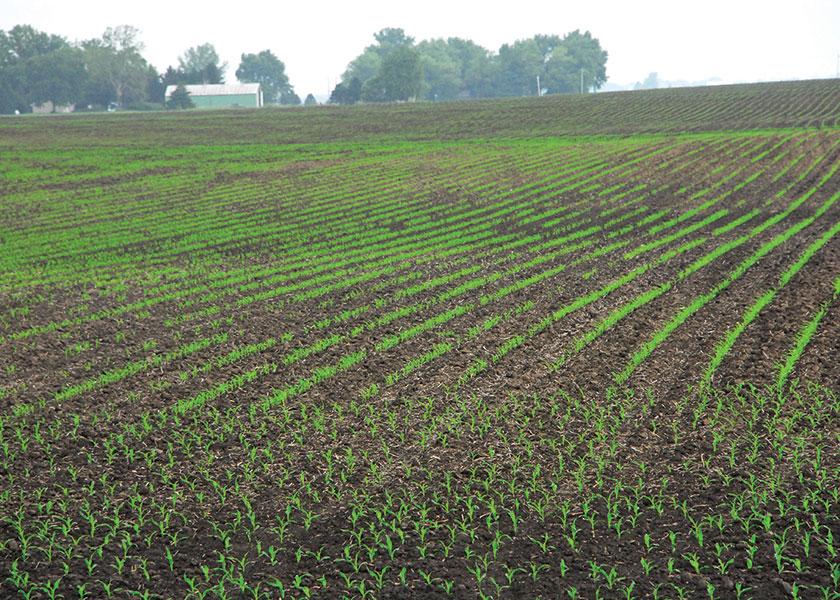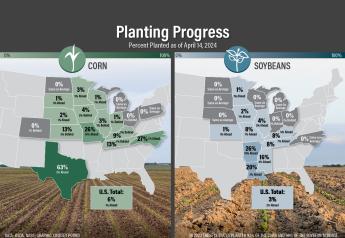What Went Wrong In My Corn Field?

Ear count, not just population, makes corn yield. The first step to more ears per field is stand and ear counts. Determine the causes of gaps, late-emerging plants and missing ears so you know how to fix the problems in the future.
Gaps In The Stand
“Identify the cause of missing plants during early stand evaluation, from emergence to the V6 growth stage,” says Farm Journal Field Agronomist Ken Ferrie. “Dig to find seeds or plants before the evidence is lost.”
Possible culprits include poor- quality seed, misplaced seed, animal predation, seed chilling, insects, diseases or fertilizer burn.
With misplaced seed, you’ll find an extra seed down the row from the gap, Ferrie explains.
“That may result from worn seed tubes on your planter, static electricity at the meter combined with too little talcum or a planter running nose-down,” he says.
Here are some common reasons you see gaps in your fields:
- A hole where a plant should be suggests wildlife feeding.
- In ungerminated seed, holes in the pericarp indicate likely insect damage.
- Plants present below ground but missing above might have been eaten by wildlife or sheared off by cutworms.
Seed chilling can cause skips and/or late emergence in corn. “Seed might not germinate,” Ferrie says. “You might find a shoot without roots or roots without a shoot. The most common effect is corkscrewing, with the shoot failing to reach the surface.”
High-quality seed and seed treatments can help.
“But you must identify the cause,” Ferrie says. “An insecticide treatment won’t help if the problem is chilling or fertilizer burn.”
Uneven Emergence
Causes of late emergence remain visible all season. “Dig good and bad plants in multiple areas of the field, and compare them,” Ferrie says. “Sound roots will show no evidence of how seed was placed in the soil. Crown roots should come off the stalk in a circular pattern, growing downward at a 30˚ angle.”
Tip a plant upside down. “If roots are growing in the line of the seed trench, you have sidewall smearing,” Ferrie says. “Another indication is when the soil has a seam and splits into two halves at the seed trench. Sidewall smearing results from excess down pressure and/or planting into wet soil.”
If the roots look normal, check planting depth by removing the mesocotyl from the base of the crown; measure it and add ¾".
“If small plants are shallower than others, the row unit was not staying in the ground,” Ferrie says. “Causes include planting too fast, too little downforce, worn-out disk openers or too aggressive of a setting on spader closing wheels.
“If late-emerging plants are deeper, it suggests a false bottom in the furrow,” Ferrie continues. “This occurs most often in strip-till. It happens if a planter is running on its nose, causing the row-unit coulter to run below the seed depth. If soil is loose or has an air pocket where the opener runs, seed firmers will tuck the seed down there.”
If seed depth is uniform, look for discoloring on the mesocotyl, indicating seedling disease.
Seed Orientation
“When seed is planted spike-down, the mesocotyl must turn around the seed to head for the surface,” Ferrie says. “If you find late-emerging seeds were planted spike-down, the soil was too cold for a long period after planting.”
Cold soil cannot be overcome with seed treatments and planter attachments, but a bigger or high-speed planter could help if it will let you wait for soils to warm.
“We seem to have fewer days with ideal conditions, which forces us to find ways to plant more acres while conditions are right,” Ferrie says.
Other Field Clues
If a plant leafed out underground, see if it pushed against a crust before leafing. “If it did, the spike will swell at the soil line and leaves will break out to the side of the spike,” Ferrie says. “Rotary hoe problem fields to avoid crusting.”
If the spike isn’t swelled, underground leafing may mean herbicide stress, seed chilling or an open slot that exposed the spike to sunlight before it broke the surface.
Ear Count Tips and Tools
Ear-count analysis is a year-round procedure. “At harvesttime, normal plants with poor ears indicate a problem in the reproductive stages,” says Farm Journal Agronomist Ken Ferrie. “Possible causes include rootworm beetles or corn aphids disrupting pollination, corn borers in the ear shank and diseases.”
If individual plants have poor ears, it’s probably from insects or diseases such as crazy top and corn smut. Nutrient deficiencies rarely affect single plants.
Areas with uniformly poor stands or poor ear development probably reflect environmental issues, such as wet soil, compaction or running out of nitrogen.
“Compare poor zones and good ones,” Ferrie advises. “Soil and tissue testing might help.”
Use as-applied mapping technology if you have it. It can help you correct problems and boost ear count next season. Studying maps as you plant next spring can help you fix problems before they create stand and emergence issues.







